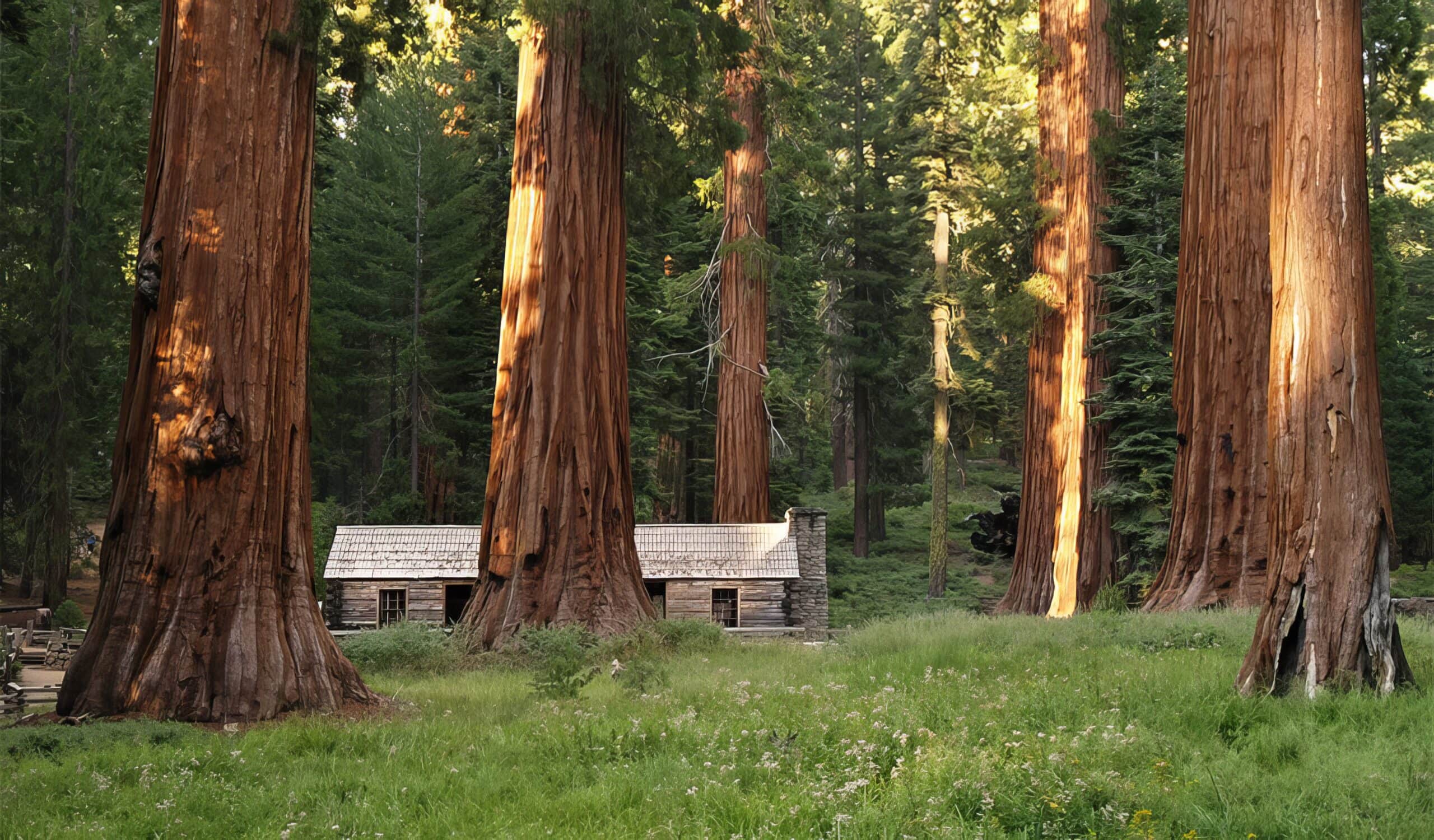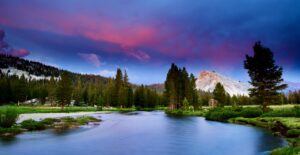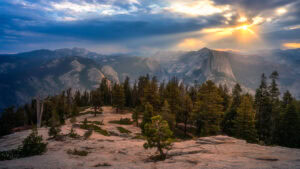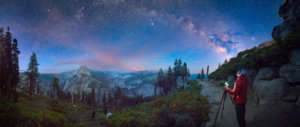The giant sequoia tree, Sequoiadendron giganteum, is a perspective-bending wonder to behold. These majestic beauties burst skyward along the western slope of California’s Sierra Nevada where they can thrive for 3,000 years and more ““ among the oldest living things on Earth. Their rough, cinnamon-red trunks are truly massive, and some of their lofty, gnarled branches could be big trees in their own right.
Yosemite Mariposa County has the arboreal honor of being home to three designated giant sequoia groves (and two more just to its north and south), making it a great place to “branch out” for a grove-hopping itinerary. Prepare to be awestruck.
Merced Grove of Giant Sequoias
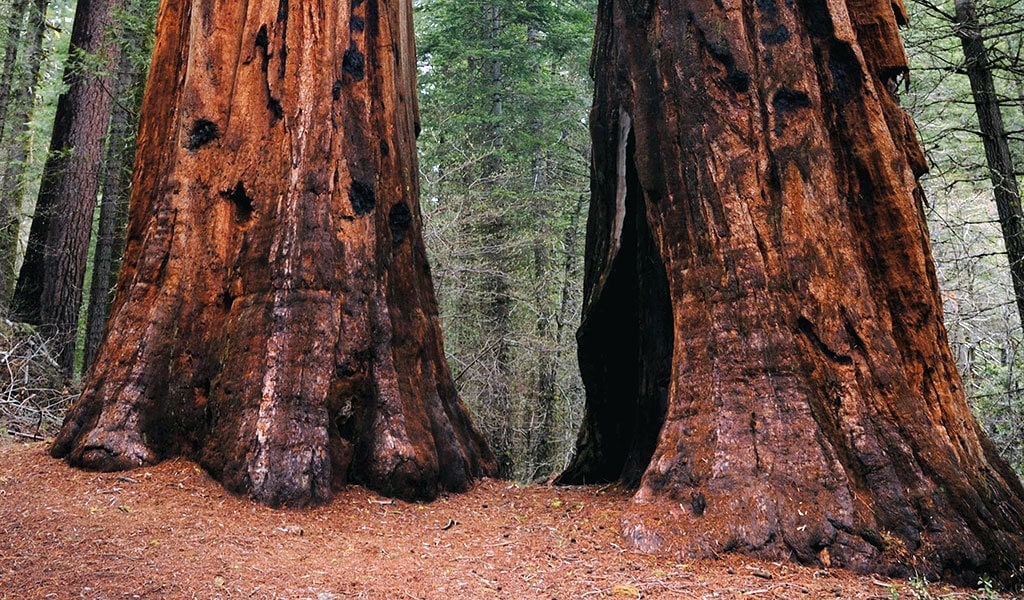
For visitors in search of these gentle giants, two of Yosemite National Park’s three giant sequoia groves are found just off Highway 120. Merced Grove is the smallest of them. Because “small” seems like an odd adjective whenever describing these big trees, let’s say that Merced Grove is the most compact giant sequoia grove in Yosemite with around 20 mature trees. And due to its modest scope, this may be the quietest grove in Yosemite with a cathedral-like grace.
Access to Merced Grove is via a three-mile loop trail, unpaved but wide and smooth. The trail is all downhill to the grove, with about 600 feet of elevation gain on the way back to the parking lot. There is an excellent interpretive sign and map at the trailhead to the grove. Its two named tree clusters are Sequoia Row and Twin Sequoias. You’ll hike along the historic Old Coulterville Road, built in the 1870s as the first road into Yosemite Valley.
A note for this and all grove visitors: giant sequoias may appear immortal but their shallow roots can extend for hundreds of feet from the trunk in every direction and are quite vulnerable to damage. Always keep behind the fenced areas around their trunks and avoid walking near the bases of these titans.
The Merced Grove is located between the Park’s Big Oak Flat entrance and Crane Flat. From Yosemite Valley, take 120 north just over 13 miles to the well-marked trailhead on your left. Parking is extremely limited. Water is not available; bring drinking water for everyone in your group who will be hiking this trail.
Tuolumne Grove of Giant Sequoias
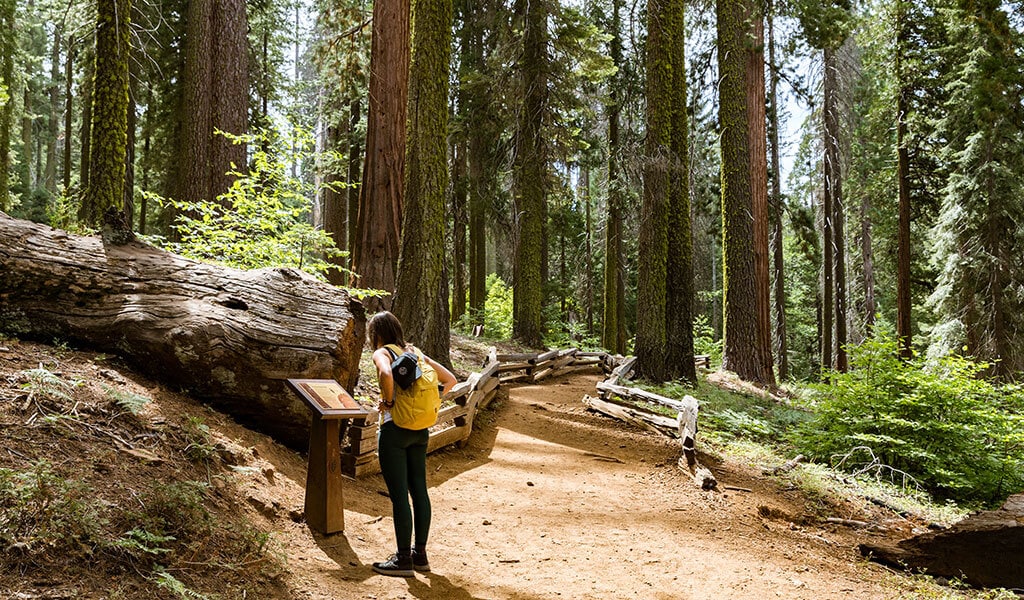
Just a few miles east of Merced Grove on Highway 120, Tuolumne Grove hosts about two dozen giant sequoias rising from a gorgeous Pacific dogwood understory.
The Tuolumne Grove trail takes you to this stand of giants via a relatively easy hike (2.5 miles out & back/500 ft elevation gain), all downhill from the parking lot (and, of course, uphill on the return). You’ll be walking on what was originally a segment of the old Big Oak Flat Road that served early Yosemite pioneers, gold miners, and settlers more than 150 years ago.
Giant sequoia trees begin to appear at about the one-mile mark from the parking lot and once you arrive at the grove, there’s a short loop trail that takes you around to all the two-dozen giant sequoias there including Big Red and the Dead Giant tunnel tree. Remember to bring all the water your group will need, as there is none available at the grove.
The Tuolumne Grove trail is also a popular venue for both cross-country skiing and snowshoeing. In the summer months, if you’re driving over seasonally-open Tioga Road to experience Northern Yosemite, Tuolumne Grove is a great first stop to stretch your legs in the company of these colossal giants. To reach the Tuolumne Grove, turn onto Tioga Pass from Big Oak Flat Road at Crane Flat and look on the left for the parking area.
Mariposa Grove of Giant Sequoias
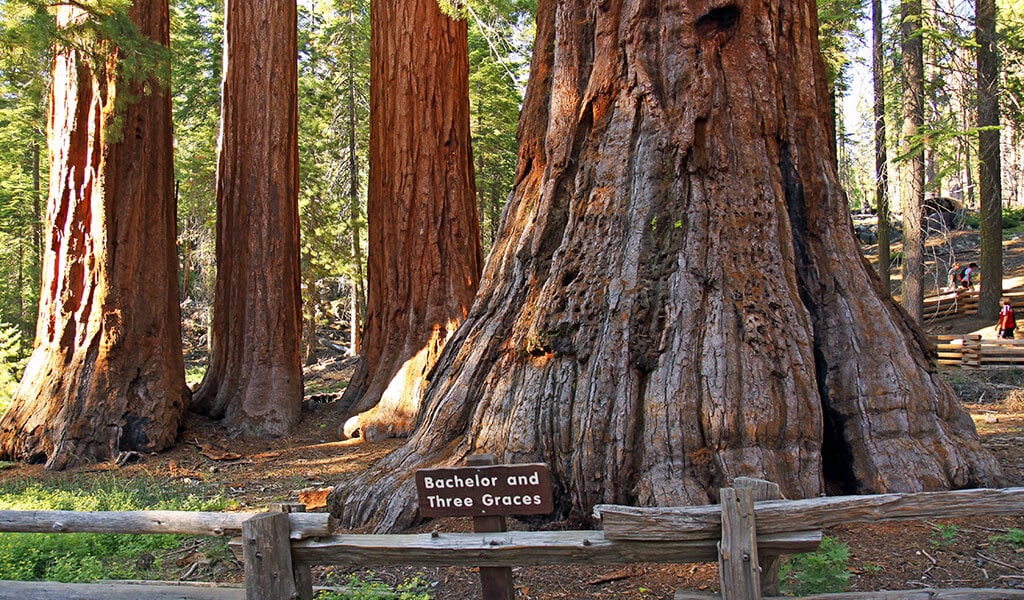
Tucked just inside Yosemite National Park’s South Gate, the Mariposa Grove of Giant Sequoias is the most expansive of Yosemite’s big tree hubs with some 500 mature titans and a dedicated welcome plaza/visitor center! Follow the Big Trees and Grizzly Giant loop trails to see such specimens as the Fallen Monarch, the Wawona and California Tunnel Trees, and the grove’s reigning elder, the Grizzly Giant “” estimated to be 2,700 years old. Visitors with a valid disabled placard can drive as far as the Grizzly Giant parking area and enjoy this area of the grove via a section of trail that is wheelchair accessible.
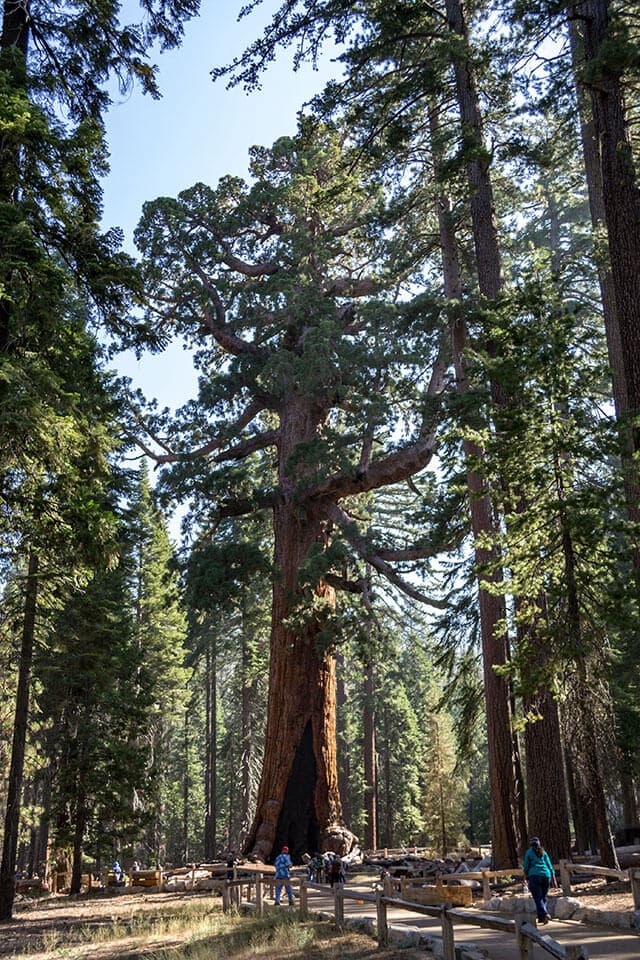
For those willing to go the extra mile in search of boss branch benefits, lace up and pack a lunch to discover the less-visited plateau of the upper Mariposa Grove. This is forest majesty on an entirely new level. Follow the Mariposa Grove Trail up to the Guardians Loop Trail and the fallen Wawona Tunnel Tree, Telescope, Galen Clark, Faithful Couple, and Mariposa trees. The upper grove has a distinctive, timeless grace where the trees are older, bigger, and more majestic and people are fewer. In the Mariposa Grove, those willing to walk the extra miles are truly rewarded.
Visitors should plan between two and six hours to visit Mariposa Grove. A minimum of 2 hours to visit the lower grove with parking, shuttle round trip, and a walk to the Grizzly Giant located in the lower grove, and return. We highly recommend spending an additional two hours or more walking the upper grove loop trail to truly take in the majesty of these gentle giants!
Take that extra step into arboreal bliss by hiking the short spur up to Wawona Point (elev. 6,800′), a beautiful overlook with panoramic views. The hike to the upper grove is strenuous at about seven miles round-trip with 1,200 feet elevation gain.
Nelder Grove
The Nelder Grove of Giant Sequoias is located nine miles south of Fish Camp in the Sierra National Forest. The grove was named for John Nelder, who traveled to the region from New Orleans in 1849 for the California Gold Rush. After he grew weary of the prospecting game, he came to the grove in 1875 and discovered the true treasure of nature. John Muir met Nelder there and described the encounter in his book, Our National Parks:
“His eyes brightened as he gazed on the trees that stand guard around his little home; squirrels and mountain quail came to his call to be fed, and he tenderly stroked the little snow bent sapling Sequoias, hoping they yet might grow straight to the sky and rule the grove.”
Today Nelder Grove offers about 60 mature giant sequoias rising across more than 1,500 acres. Among them, the massive Bull Buck Tree is worth the walk. Ladybugs and monarch butterflies migrate through the grove as well. If you go, download the well-designed and informative An Interpretive Guide to the Nelder Grove Area from the Friends of Nelder Grove website.
To get to Nelder Grove, take Highway 41 north from Oakhurst to Road 632/Sky Ranch Road and follow the detailed directions here. Low clearance vehicles are not advised as much of the route is via unimproved dirt roads.
Big Trees Extra Credit
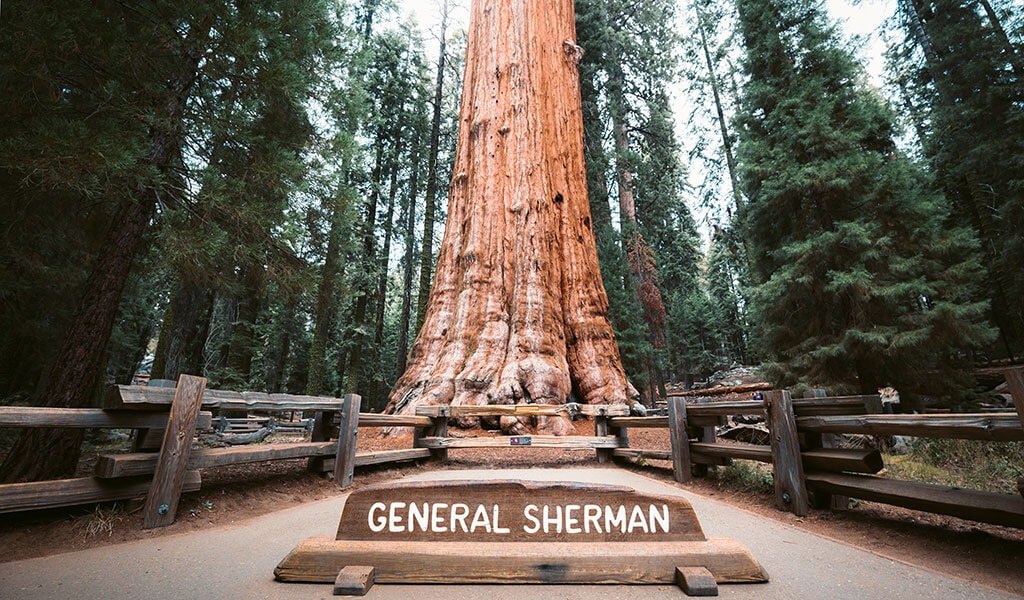
If your Yosemite Mariposa County grand tree tour leaves you wanting just a little more, consider visiting a few more western Sierra Nevada parks where Sequoia superflora thrive.
Sequoia & Kings Canyon National Parks offer more than forty different groves and the world’s largest tree, General Sherman, approximately 160 miles south of Yosemite and 95 miles from Fresno International Airport.
Calaveras Big Trees State Park offers two giant sequoia groves and the Three Senses Trail, a short loop that presents a fun sensory experience through the forest. Calaveras Big Trees State Park is about 80 miles north of Yosemite National Park along Highway 4, about 150 miles east of the S.F. Bay Area.
Giant Sequoia Fun Facts
- The “California Redwood” is the state tree, including both the giant sequoia and the coast redwood.
- Sequoias, both giant and coastal, are named for the Cherokee leader Sequoya who invented a phonetic alphabet of 86 symbols for the Cherokee language. The language, still taught today, was one of the few times in recorded history that a member of a pre-literate people created an original system of writing.
- The cones from giant sequoias fit easily into the palm of your hand. The seeds inside the cones are tiny, about the size of a pinhead! The only way these cones germinate and turn into a sequoia sprout is with the help of fire.
- Local Western Mono Native Americans believed the big trees were sacred and protected by owls, their guardian spirit animal.
To explore lodging options, things to do and places to eat, visit Yosemite.com, the #1 trip planning site for vacations to Yosemite National Park and historic Mariposa County. To stay up to date, follow @YosemiteNation on social media and subscribe to our newsletter, “The Wanderer”. Be sure to subscribe to our YouTube channel for great videos on the people and places of Yosemite Mariposa County.

